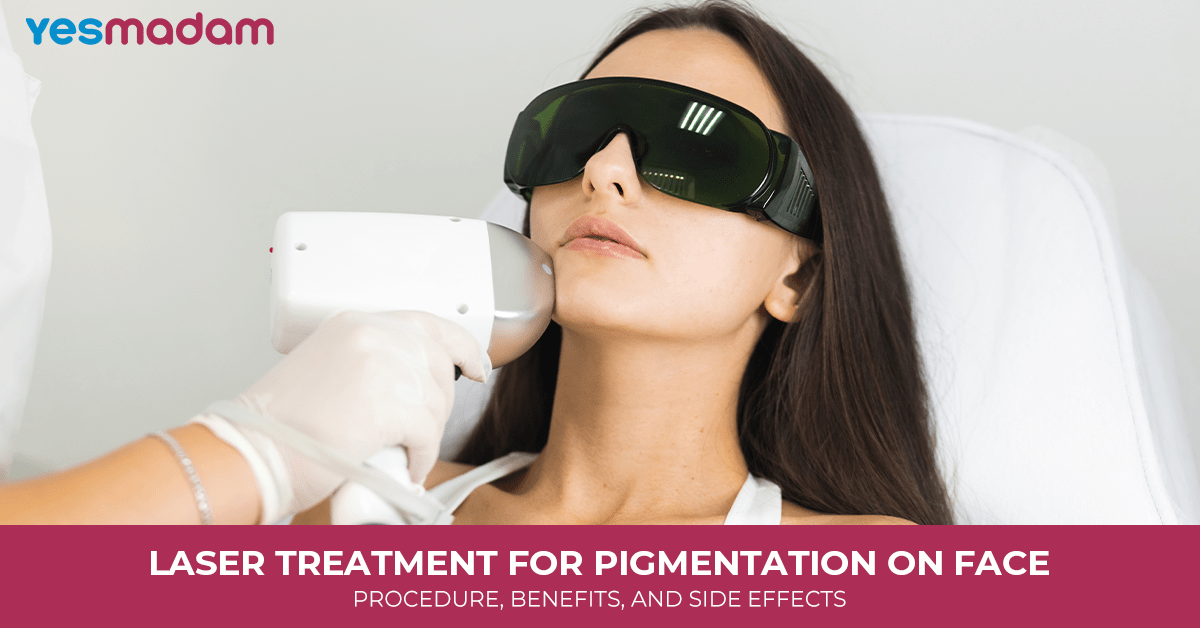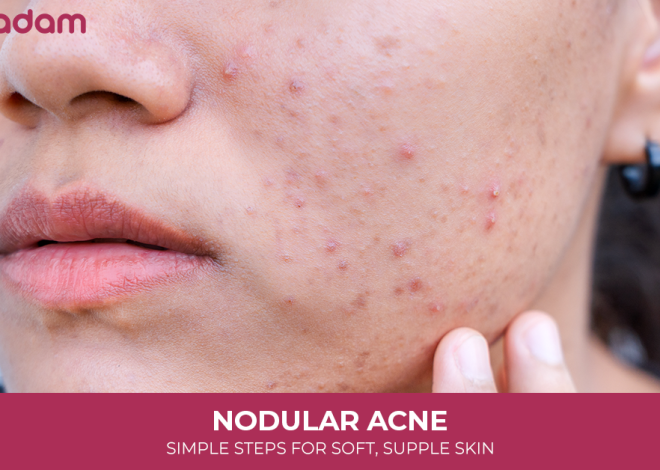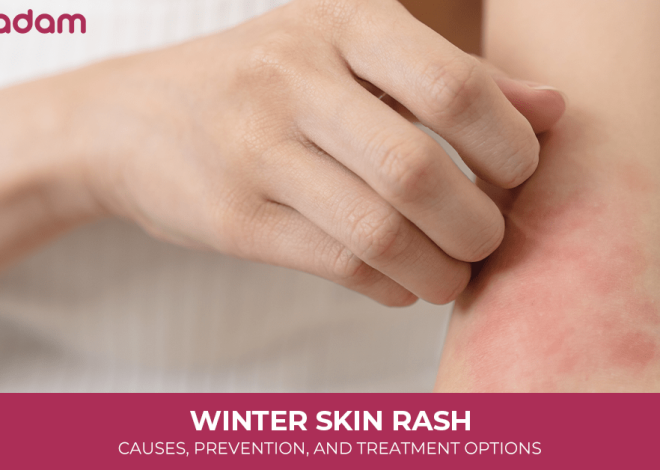
Laser Treatment for Pigmentation on Face: Procedure, Benefits, and Side Effects
Having clear, pigmentation-free skin is something we all crave. To achieve that flawless texture, many of us follow different skincare routines, dermatologists’ suggestions, and home remedies. However, these methods require consistency and take time to show results.
If you want to get rid of pigmentation issues without going through a long cycle of applications and strict routines, laser treatment for pigmentation on the face is an effective option. Yes, you heard it right, modern laser technology can help you achieve smooth, flawless skin in just a few sessions. To learn more, we recommend reading the full blog to get all the essential information before choosing laser treatment.
Table of Contents
What is Laser Treatment for Pigmentation?
Laser treatment for pigmentation on the face works by breaking down excess melanin in the skin, helping to reduce dark spots and other causes of uneven skin tone. With this treatment, people can effectively address common concerns like age spots, melasma, and sun tanning.
The process involves targeting pigmented or discolored areas with laser energy. The melanin absorbs this energy, causing it to fragment and gradually get eliminated naturally by the body.
How does Laser Treatment for Pigmentaion on Face Work?

Laser treatment targets the root cause of pigmentation, excess melanin in the skin. The procedure works in the following steps:
Consultation and skin analysis: A dermatologist examines your skin type, pigmentation level, and suggests the right laser.
Preparation: The area to be treated is cleaned, and protective eyewear is provided. Sometimes a numbing cream is applied for comfort.
Laser application: A focused beam of laser light is directed onto the pigmented area. The melanin absorbs this light, causing it to break into smaller particles.
Natural elimination: Over time, the body’s immune system clears these fragmented pigments and reduces spots and discoloration.
Healing and results: Mild redness or sensitivity may occur temporarily, but skin gradually appears clearer and more even-toned with each session.
Type of Laser Treatment for Pigmentation on Face
Different types of lasers are used to treat facial pigmentation, depending on the cause, severity, and skin type. Here are the most common ones:
1. Q-Switched Nd:YAG Laser
- One of the most popular choices for pigmentation.
- Works by targeting melanin and breaking it into tiny particles that the body naturally clears.
- Effective for freckles, sunspots, age spots, and post-acne marks.
- Usually requires multiple sessions.
2. Fractional Lasers (Fraxel, Fractional CO₂, Er:YAG)
- Treat both pigmentation and skin texture issues.
- Create tiny “micro-injuries” in the skin, stimulating collagen and faster healing.
- Useful for melasma, acne scars, and deeper pigmentation.
- May need some downtime depending on the strength used.
3. Pico Lasers (Picosecond Technology)
- Newer technology that delivers laser energy in ultra-short pulses.
- Targets stubborn pigmentation with less heat, reducing risk of side effects.
- Often used for melasma, sun damage, and tattoo removal.
- Minimal downtime and safe for many skin types.
4. Intense Pulsed Light (IPL) – Not a Laser, But Similar
- Uses broad-spectrum light rather than a single wavelength.
- Effective for mild pigmentation, redness, and overall skin brightening.
- Works best for sun damage and uneven skin tone.
5. Alexandrite Laser
- Highly effective for treating brown spots, freckles, and sun-induced pigmentation.
- Penetrates deeply and works best for lighter skin tones.
More Information For You: Types of Laser Treatments for Face
Top Benefits of Laser Treatment for Pigmentation on Face
Laser treatment for pigmentation has become one of the most effective ways to achieve a smoother, more even skin tone. It not only fades stubborn dark spots but also improves overall skin texture and radiance.
Here’s a simple breakdown of its benefits
1. Targets Deep Pigmentation
Unlike creams or peels that work on the surface, lasers reach deeper layers to break down excess melanin more effectively.
2. Treats Multiple Concerns
Lasers can help with:
- Age spots
- Sunspots
- Melasma (patchy pigmentation)
- Post-acne marks and scars
3. Precision with Minimal Damage
Modern technology, like Q-switch lasers, precisely targets pigmentation without harming surrounding skin. This reduces the risk of side effects.
4. Quick Recovery
Most people experience little to no downtime. You can return to daily activities almost immediately.
5. Enhances Skin Texture & Glow
Beyond fading dark spots, laser treatments smooth out uneven texture, boost collagen, and restore natural radiance.
6. Long-lasting Results
With proper skincare and sun protection, results can last for months or even years, making it a worthwhile investment in your skin health.
7. Suitable for Different Skin Types
Advanced lasers are designed to be gentle on various skin tones, but it’s important to consult a dermatologist for the safest and most effective treatment plan.
Don’t Miss: Is Glycerine Good for Oily Skin
Common Laser Treatment for Pigmentation on Face Side Effects

Laser treatment can improve skin tone, but it may also cause some side effects. Most are mild and temporary, while serious issues are rare.
Here’s what you should know:
Common Side Effects
- Redness and swelling: The skin may look red and slightly puffy, like a mild sunburn. This usually goes away within a few hours or days.
- Changes in skin color: The treated area can become darker (hyperpigmentation) or lighter (hypopigmentation). In most cases, this is temporary.
- Itching or burning: Some people feel mild irritation or warmth after treatment.
- Acne breakouts: Thick creams or dressings applied afterward can sometimes cause small pimples or white bumps.
Less Common but Serious Side Effects
- Infection: If the skin is not cared for properly, infection can occur and may need antibiotics.
- Scarring: Uncommon, but more likely with stronger laser treatments.
- Texture changes: Skin can sometimes heal unevenly, especially if it was recently tanned.
- Eye damage: If lasers are used near the eyes without protection, they can cause harm.
- Cold sore flare-ups: People who carry the herpes virus may experience outbreaks after treatment.
- Pigmentation returning: In some cases, dark spots can come back, especially without sun protection.
Most side effects are short-lived and easy to manage. Choosing a qualified dermatologist, following aftercare instructions, and using sunscreen daily may reduce possible pigmentation laser treatment side effects and help you get the best results.
Things to Follow After Laser Treatment for Pigmentation on the Face (Value Added)
Taking proper care of your skin after laser treatment is just as important as the procedure itself. Good aftercare helps your skin heal faster, reduces side effects, and ensures the best results.
1. Keep Your Skin Cool and Calm
Your skin may feel warm or sensitive. Use a gentle, cool compress if needed, but avoid rubbing the area.
2. Moisturize Regularly
Apply a mild, fragrance-free moisturizer or healing ointment recommended by your doctor. This prevents dryness and supports healing.
3. Avoid Sun Exposure
The skin is more sensitive after treatment. Always use a broad-spectrum sunscreen (SPF 30 or higher) and avoid direct sunlight as much as possible. Hats and scarves can add extra protection.
4. Skip Harsh Products
Stay away from scrubs, retinol, chemical peels, or strong skincare products until your dermatologist says it’s safe. Stick to gentle cleansers and soothing creams.
5. Don’t Pick or Scratch
The treated area may peel or flake as it heals. Let it happen naturally and avoid scratching to prevent scarring.
6. Stay Away from Heat
For a few days, avoid hot showers, saunas, steam rooms, or intense workouts that make you sweat, as these can irritate the skin.
7. Watch for Unusual Changes
Mild redness and swelling are normal, but if you notice severe pain, pus, spreading redness, or anything unusual, contact your dermatologist.
8. Follow Medical Advice
Always follow the specific aftercare instructions given by your dermatologist, as recommendations can vary depending on the type of laser used.
Conclusion
laser treatment for pigmentation on face is a powerful option for those seeking clearer, more radiant skin without relying only on lengthy skincare routines. By directly targeting excess melanin, it reduces dark spots, evens skin tone, and improves texture in just a few sessions. While mild side effects may occur, proper aftercare and sun protection ensure safe, long-lasting results. With modern laser technology and guidance from a qualified dermatologist, achieving healthy, youthful, and pigmentation-free skin is now more possible than ever.
FAQs
1. What is laser treatment for pigmentation?
Laser treatment uses focused light energy to break down excess melanin in the skin, helping reduce dark spots, uneven skin tone, and pigmentation issues.
2. Is laser treatment safe for the face?
Yes, when performed by a qualified dermatologist, it is considered safe. Side effects are usually mild and temporary.
3. How many sessions are needed for results?
Most people need 3 to 6 sessions, depending on the severity of pigmentation and the type of laser used.
4. Does the treatment hurt?
You may feel a slight stinging or warming sensation during the procedure, but numbing cream is often applied to make it more comfortable.
5. What types of pigmentation can lasers treat?
Lasers are effective for freckles, age spots, sun damage, melasma, and post-acne dark marks.
6. How long do the results last?
Results can last for months or even years with proper skincare and regular sun protection.
7. What are the possible side effects?
Common side effects include redness, mild swelling, temporary skin darkening or lightening, and slight irritation. Rarely, infection or scarring may occur.
8. Can all skin types undergo laser treatment?
Yes, modern lasers are suitable for most skin types, but your dermatologist will recommend the safest option for you.
9. Is there any downtime after the procedure?
Most people experience little to no downtime and can return to normal activities within a day or two.
10. What should I avoid after treatment?
Avoid direct sun exposure, hot showers, harsh skincare products, and picking at the treated skin. Always use sunscreen daily.



